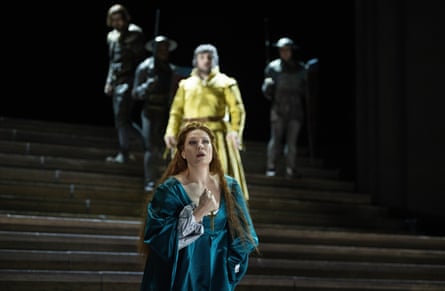‘I’ve lost all reason!” sings Count di Luna halfway through Verdi’s Il trovatore – and fair enough. At this point in Adele Thomas’s production, already seen in Zurich but new to London, reason is a distant memory, chased away by the mayhem of malignity on stage and the fervent music Antonio Pappano is whipping up in the pit.
In its place is a kind of 15th-century sensibility, into which we enter through a curtain formed by the jaws of a monster straight out of a medieval bestiary. What if this far-fetched story of a doomed troubadour were to have been told by a troubadour itself? It would have been tear-jerking, certainly bloodthirsty – but definitely not po-faced: that would risk losing its audience. And so Thomas’s staging, designed by Annemarie Woods, finds ways to be entertaining without diminishing the tragedy. In its anarchic imagination and the precision with which its cruelty and crudity are executed, it feels inspired by Hieronymus Bosch – but with the lovers, Leonora and Manrico, lit as if by Vermeer.

The action takes place against a black, blank background, on wide steps that recall Barrie Kosky’s interrogation of Bizet’s Carmen, a production that divided audiences as much as I suspect this one will. It’s surrounded by three concentric picture frames, which look beautiful from the front but won’t help sightlines. All is presided over by the Count’s henchman Ferrando, here elevated to be a controlling force, very well sung by Roberto Tagliavini. If he’s not the devil incarnate – and he might well be – he is at the very least a sinister Lord of Misrule, with half a dozen dog-like dancer-creatures to enforce his bidding.
Thomas injects levity via the opposing armies, casting them as pitiful Pythonesque pawns. In the Anvil Chorus some pop up through trapdoors, fingers gleefully in ears against the anvils’ deafening ding, while their colleagues caper and floss behind them. But the central characters are taken very seriously – more so than before in the case of the Count, who had a garish pink costume in Zurich but is now dressed in stout layers of cloth of gold. Ostensibly the villain, in this complex story he gets the loveliest of love songs, which Ludovic Tézier delivers sombrely and with velvet tone.

Tézier is well matched with Riccardo Massi’s ardent Manrico, Jamie Barton finds depth of expression in Azucena’s every line, and as Leonora Marina Rebeka spins out a diamond-brilliant soprano tone that swells and recedes with the orchestra’s expansive phrases. The chorus is on fine form – the offstage nuns sound as beguiling as sirens – and the orchestra paints the horrific backstory in vivid colour. No, there’s not a lot of reason in this Trovatore, but its storytellers Thomas and Pappano are both razor-sharp.

Comments (…)
Sign in or create your Guardian account to join the discussion